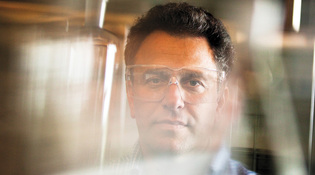 loading
loading
West Campus: The pioneers Christopher CapozzielloJonathan Ellman's work melds chemistry with biology to develop the best techniques for making drugs. View full image
From test tube to doctor’s office Jonathan Ellman is a master of technical, minute processes—like tert-butanesulfinamide chemistry—whose names are foreign and abstract to those in the general public. But his technical work is highly relevant to anyone who has ever filled a prescription, and his research will likely continue to improve human health. The chemist recently left his post at the University of California–Berkeley to join the Institute for Chemical Diversity, Evolution, and Function, on the West Campus. Much of Ellman’s work has centered on finding simple methods for synthesizing important pharmaceutical compounds. One branch of his research focuses on designing new ways to create amines—ammonia-derived components that are found in many drugs. This is where tert-butanesulfinamide chemistry comes in: Ellman pioneered the technology in the late 1990s to streamline amine production. ”Every single pharmaceutical company now uses this method toward synthesizing drugs. It allows them to put compounds into clinical trials more rapidly by converting simple, commercially available compounds into more-complex bioactive structures,” he explains. Recently, Ellman and his team used the process to synthesize the potential antitumor agent tubulysin D, a natural product that inhibits cell growth more potently than several currently available anticancer agents. Working with researchers at Berkeley and the University of California–San Francisco, Ellman has shown that the chemical can eliminate certain colon tumors in mice. He has also pioneered an efficient method to convert common carbon-hydrogen bonds into more unusual chemical connections. This process has been recently used to synthesize a plant-derived chemical that is in early stages of development but may have promise to slow down neurodegenerative diseases. In addition to his chemical synthesis projects, Ellman explores the chemistry of processes within the body, in hopes of developing treatments for little-understood medical conditions. Currently, his laboratory is developing complex chemical tools that will help researchers study how proteases—enzymes that regulate numerous biological processes—bind to other proteins. This information could help identify ways to slow down such enzymes when things go awry. “Since proteases play important regulatory roles in a number of diseases, Jon’s work is likely to have a big impact in terms of new therapeutic agents making it to market,” says Stanford University’s Matthew Bogyo, who collaborates with Ellman to uncover potential treatments for malaria.
The comment period has expired.
|
|